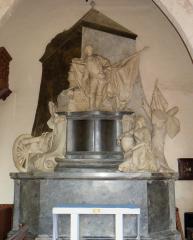 Roubiliac's Viscount Shannon monument, Walton on Thames.
Roubiliac's Viscount Shannon monument, Walton on Thames.
 Roubiliac's Viscount Shannon monument, Walton on Thames.
Roubiliac's Viscount Shannon monument, Walton on Thames.
In Surrey, far inland along the River Thames, the church of St Mary, Walton on Thames, in Surrey, houses a grand memorial of a size, grandeur and excellence to rival anything in Westminster Abbey. It is the memorial to Richard Boyle, Viscount Shannon, the second and last holder of that title, as he left a daughter and no sons. It is to the daughter we owe the memorial.
The Viscount Shannon memorial, made in the mid-1750s, occupies a whole arch-width of the north aisle of the Church, and stands in several tiers well over 20 ft high. The first tier is a sideboard-like construction of grey brecciated marble forming the base to the sculpture and the pedestal to Viscount Shannon, who stands upright, in front of a backing panel rising high above his head, in black, light grey and dark grey, to form the shape of a pavilion. Looking at the outline of base and tent, we have a roughly obelisk shape, with the sculpture projecting forwards from this in a pyramidal composition, the apex formed by Viscount Shannon, and the two lower corners filled by a seated female statue and a tree-stump, and on the other side by a cannon, barrel of gunpowder, and heaped cannonballs and smaller accoutrements, for Viscount Shannon was a military man. The intrinsic asymmetry between the female figure and the cannon is made the more so by the posture of the Viscount, who is leaning rather than standing straight, the long flagpole behind him, which angles far to the right which is the side where the flag hangs, and below that, the tree stump, which is large for its purpose as support for a pair of drums and associated paraphernalia. The group as a whole therefore has more mass to the right as we view it, and this may be to counteract the visual weight of the dark side of the tent behind, which otherwise would be too dominant on the left hand side. So overall, visual balance is preserved.
Richard Boyle, Viscount Shannon statue. 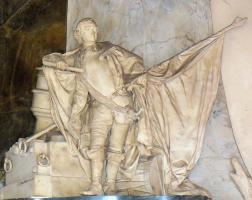
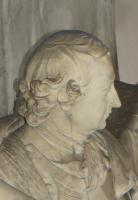
The statue of Viscount Shannon is flamboyant, swaggering even, dressed in uniform of the time note the floppy topped boots and over his tunic is a grand robe whose generous folds to back and sides give substance and gravitas to the figure. He leans one arm on a heavy mortar, and in his gloved hand holds some tubelike object, perhaps holding his spyglass.
The female figure is perhaps the Viscount's daughter, Grace, Countess of Middlesex, or some sources say she is Lady Grace, wife of the Viscount. Both would be plausible from the inscription, which refers to the monument being 'erected by his only daughter, Grace, Countess of Middlesex ... in obedience to the Will of her mother Grace... whose ashes, together with those of her beloved Lord, are here deposited. On the one hand, with both parents deceased, the monument could show them both living, with Lady Grace holding the funereal casket to indicate she outlived her husband; on the other, it could be that the daughter is shown mourning her deceased parents, represented by the inscription, with the Viscount getting the statue in what was then a very male-centric culture. Hmm. On the whole, it seems odd to show the daughter and only one of the parents, so I would incline to the female statue being Lady Grace the wife rather than Countess Grace the daughter.
Regardless of who is represented by the female statue, she is seated with one arm around the top of a funereal urn, her head lying somewhat backwards and upward pointing in her distracted grief, and so able to point towards the statue of the Viscount though she is not looking at him, it would look odd compositionally if her gaze appeared to be directed elsewhere. The monument invites the viewer to walk around to the sides to view it from different aspects. Doing this allows us to see how the optical illusion of the cannon being in alto relievo and pointing rather to the side, still manages to give the viewer from the front the impression of staring down the gun barrel it is actually curved! This can be seen in the picture below, if you click to enlarge.
Treestump, mortar on which the Viscount leans, and cannon showing bend in barrel. 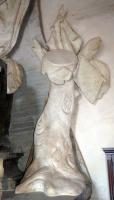
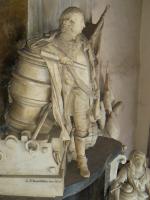
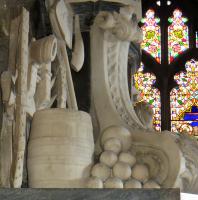
The sculptor of this splendid sculptural group is Louis-Francois Roubiliac, who was born in France, where he received his early training, but who came to London and worked for Henry Cheere, and then made his career and lived for most of his adult life in London. nRoubiliac s oeuvre included several grand monuments in Westminster Abbey, and this monument in Walton on Thames is the equal of any of them.
There are other things of sculptural interest in Walton on Thames Parish Church - see this page.
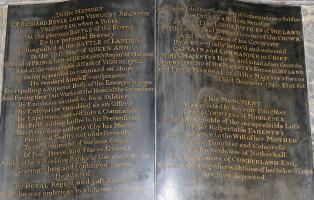 Inscription (click to enlarge).
Inscription (click to enlarge).
With many thanks to the Church authorities for permission to show pictures of the memorial; their website is http://www.waltonparish.org.uk/about/st-marys/our-story.
This page was originally part of a 'sculpture of the month' series, for September 2016. Although the older pages in that series have been absorbed within the site, if you would wish to follow the original monthly series, then jump to the next month (October 2016) or the previous month (August 2016). To continue, go to the bottom of each page where a paragraph like this one allows you to continue to follow the monthly links.
Also in Surrey: All Saints Church, Carshalton // St Martin's Church, Epsom // and formerly in Surrey: St Mary the Virgin, Merton // St Mary, Battersea
Introduction to church monuments // Churchyard and cemetery monuments
Angel statues // Cherub sculpture
Visits to this page from 1 Sept 2016: 4,375